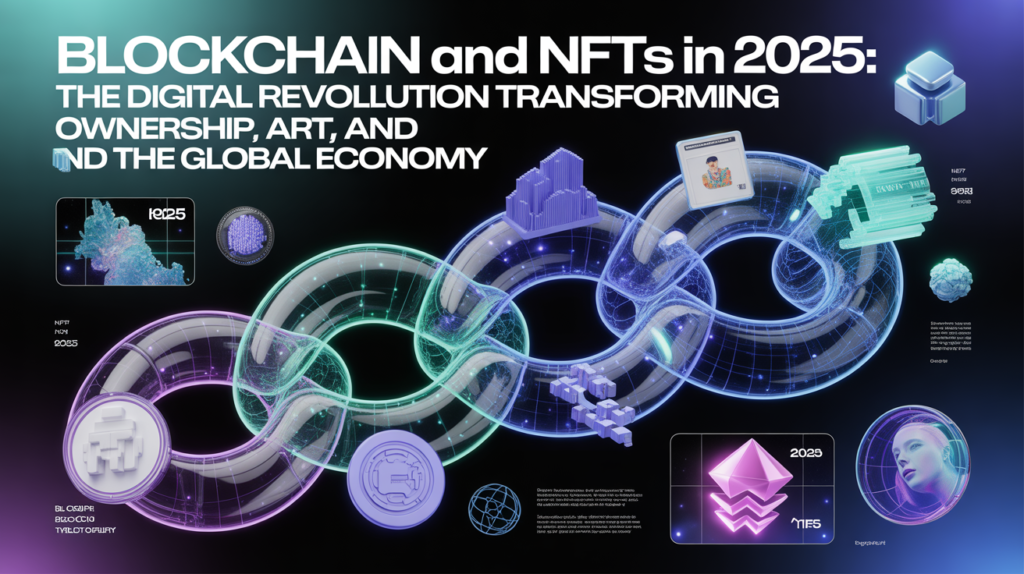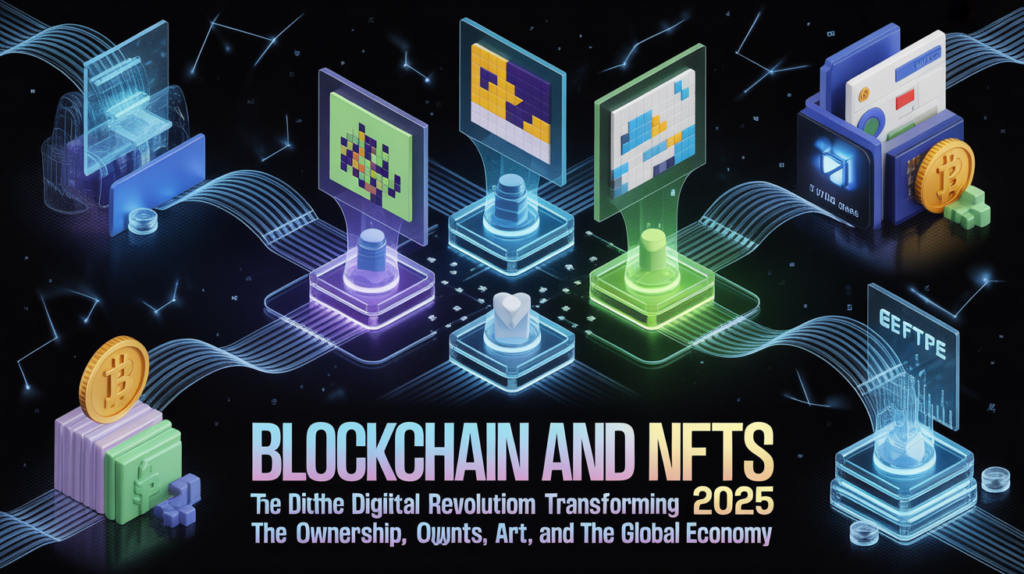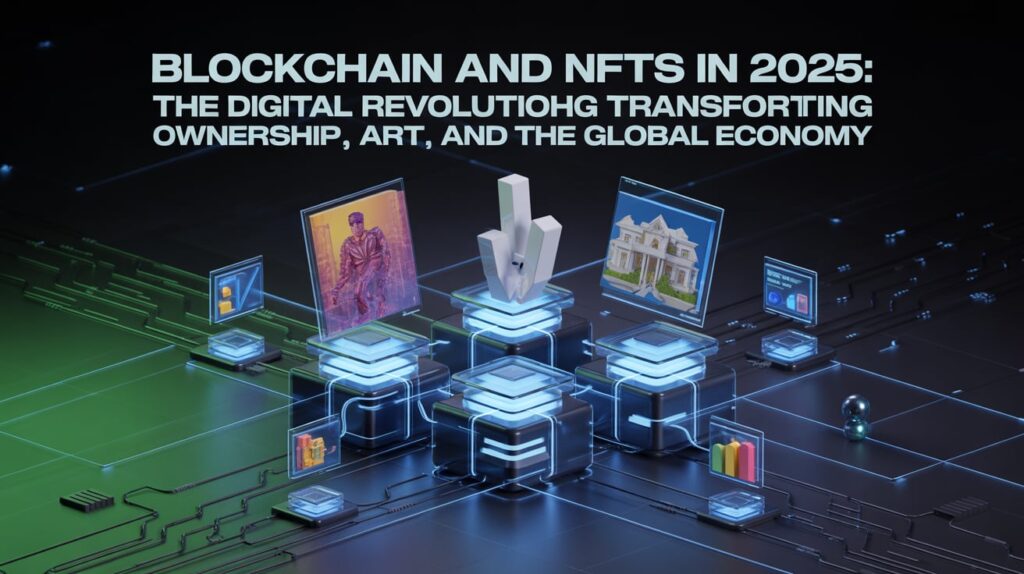🧠 Blockchain and NFTs in 2025: The Digital Revolution Transforming Ownership, Art, and the Global Economy

Introduction: The New Age of Digital Ownership
The year 2025 marks a major turning point in how we perceive value, ownership, and creativity in the digital age.
Just a few years ago, NFTs (Non-Fungible Tokens) were hyped as million-dollar JPEGs and internet fads. But today, they’ve evolved into the backbone of a new digital economy powered by blockchain technology — a transparent, decentralized system that secures transactions, authenticates assets, and democratizes ownership.
From digital art and gaming collectibles to property titles, ticketing, and identity management, NFTs have matured far beyond speculation.
Let’s explore how blockchain and NFTs together are transforming industries, empowering creators, and shaping the future of global finance in 2025.
🔗 1. Blockchain: The Infrastructure Powering the NFT World
At its core, blockchain is the digital ledger that records ownership and transactions in a way that can’t be altered.
Every NFT, DeFi contract, or tokenized asset exists because of blockchain’s transparency and immutability.
Key Characteristics:
-
Transparency: Every NFT’s origin, ownership history, and price are visible.
-
Security: Decentralized nodes protect against tampering or fraud.
-
Programmability: Smart contracts automate royalties, transfers, and conditions.
-
Decentralization: No single authority controls access or censorship.
In 2025, blockchains like Ethereum, Solana, and Polygon dominate NFT ecosystems, while emerging players such as Aptos, Sui, and Immutable X are redefining scalability and environmental efficiency.
🎨 2. NFTs: From Digital Collectibles to Real-World Assets
NFTs were once known for profile pictures and memes. Now, they’re certificates of authenticity used across multiple industries.
Major NFT Categories in 2025:
-
Art & Photography: Artists now earn lifetime royalties via on-chain smart contracts.
-
Gaming Assets: Items, skins, and in-game currencies are tokenized and tradable across multiple games.
-
Music & Media: Musicians release NFT albums that share revenue directly with fans.
-
Real Estate & Property: Ownership titles and leases are now verified via NFTs.
-
Identity & Certification: Universities, corporations, and governments use NFTs to issue verifiable credentials.
NFTs have evolved from novelty to utility, blending seamlessly into Web3 experiences.
🌐 3. The Evolution of NFT Marketplaces

Marketplaces have matured from speculative trading hubs into full-scale ecosystems.
Leading Platforms (2025):
-
OpenSea 2.0: Focused on verified creators and on-chain royalties.
-
Blur: Dominates professional NFT trading with advanced analytics.
-
Magic Eden: Expanding cross-chain trading for Solana, Polygon, and Ethereum assets.
-
Rarible & SuperRare: Curated platforms for art and luxury NFTs.
-
Zora & Manifold: Empower creators to launch independent NFT drops.
The key trend? Ownership returns to the creator. Platforms are moving away from middlemen and toward true decentralization.
🧩 4. Web3 Integration – The Real Utility Layer
Web3 is the bridge connecting blockchain, NFTs, and the user experience.
It enables NFT integration into apps, websites, metaverses, and games — turning tokens into functional digital identities or assets.
Examples of how Web3 enhances NFTs:
-
Login via Wallet: Users access sites using wallet-based identity, not email.
-
NFT Tickets: Entry to concerts or conferences verified via wallet scans.
-
DAO Governance: NFT holders vote on decisions in decentralized organizations.
-
Loyalty Programs: Brands issue NFTs that unlock special perks or memberships.
2025’s NFT world isn’t just about collecting — it’s about participating.
🎮 5. NFTs in Gaming and the Metaverse
The gaming industry is arguably the biggest success story for NFTs.
Players now own their in-game assets, trade them on open markets, and even earn real-world income.
Game-Changing Platforms:
-
Axie Infinity 2.0: Introduced sustainable gameplay rewards.
-
Gala Games & The Sandbox: Blending gaming, music, and metaverse concerts.
-
Illuvium & Star Atlas: AAA blockchain titles with cinematic graphics and on-chain ownership.
-
Yuga Labs (Otherside): Expanding the Bored Ape universe into immersive experiences.
Gaming NFTs now represent 40% of all NFT transactions in 2025 — proving digital ownership has real economic weight.
💼 6. Real-World Use Cases of NFTs
The narrative “NFTs are only pictures” is long dead. Real-world integration has taken over.
Industries Transformed:
-
Real Estate: Property deeds are tokenized for instant verification.
-
Healthcare: Patient data and prescriptions stored as encrypted NFTs.
-
Education: Universities issue blockchain-verified diplomas.
-
Fashion: Luxury brands (like Gucci and Louis Vuitton) use NFTs for product authentication.
-
Sports: Athletes issue limited NFT collections that grant fan experiences.
This evolution proves NFTs are not just speculative — they’re infrastructure for authenticity.
🧠 7. Token Standards and Blockchain Innovation
NFTs today are smarter, greener, and faster.
New standards like ERC-721A, ERC-1155, and ERC-6551 (NFTs with wallets inside them) enable multi-ownership, programmable royalties, and dynamic updates.
Notable Blockchain Upgrades:
-
Ethereum: Continues as the default NFT hub, now with efficient rollups.
-
Polygon zkEVM: Enables low-fee, carbon-neutral NFT minting.
-
Solana: Lightning-fast NFT minting with near-zero transaction costs.
-
Immutable X: Dedicated to gaming NFTs with zero gas fees.
NFT creation has never been more affordable or eco-friendly — a crucial step for mass adoption.

💱 8. NFT Economics and Market Trends
In 2025, the NFT market stabilized after early hype cycles.
Total trading volume sits around $50 billion annually, but with real utility behind it.
Market Highlights:
-
Art & Collectibles: 25% market share
-
Gaming NFTs: 40%
-
Music & Media: 10%
-
Real-World Assets: 15%
-
Identity & Certificates: 10%
Average NFT floor prices are lower, but trading volume is more consistent — proving sustainability > speculation.
⚖️ 9. Regulations and IP Rights
Global regulators now treat NFTs seriously.
-
U.S. & Europe: New IP laws protect artists from metadata theft.
-
Japan & Korea: Enforcing tax guidelines on NFT royalties.
-
Dubai & Singapore: Emerging as pro-NFT innovation hubs.
-
EU’s MiCA Regulation: Setting clear rules for NFT classification and transparency.
This regulatory clarity is fueling institutional NFT adoption and bringing legitimacy to creators and investors alike.
🪩 10. NFTs, Brands, and Mainstream Culture
From Coca-Cola to Nike, brands now use NFTs as engagement tools, not marketing gimmicks.
Examples:
-
Nike’s RTFKT: Digital sneakers connected to physical shoes.
-
Starbucks Odyssey: NFT loyalty program with exclusive member benefits.
-
Disney & Marvel: On-chain collectibles integrated with streaming experiences.
-
Adidas Into the Metaverse: NFTs granting holders early access to limited apparel drops.
NFTs are no longer separate from real life — they’re the connective tissue between digital and physical worlds.
🌍 11. NFTs and the Creator Economy
NFTs flipped the traditional creator model.
Artists, musicians, and filmmakers now sell directly to their audience — keeping royalties, control, and ownership.
Creator Empowerment:
-
Smart Contract Royalties: Artists earn every time their work resells.
-
Fractional Ownership: Multiple investors can co-own an NFT.
-
Fan Tokens: Fans invest directly in creators, sharing in future earnings.
-
Decentralized Marketplaces: Reduce platform fees from 20% to under 2%.
In 2025, over 3 million creators worldwide have earned income through NFTs — proving Web3 is rewriting the rules of creative ownership.
🔮 12. The Future of NFTs & Blockchain (2026–2030)
The next five years will take NFTs far beyond digital collectibles.
Key Predictions:
-
AI-Generated NFTs: Artists co-create with AI to produce dynamic art that evolves over time.
-
NFT Subscriptions: Media and apps move to token-based access models.
-
Cross-Chain NFTs: Interoperable assets usable across blockchains.
-
NFT-Backed Loans: NFTs used as collateral in DeFi lending.
-
Carbon-Neutral Ecosystems: Blockchain tech becomes fully sustainable.
-
Global Adoption: Governments tokenize public records and licenses.
By 2030, the line between NFTs and everyday assets will blur completely — your ID, mortgage, and Netflix subscription could all exist as blockchain tokens.

💬 Final Thoughts: The Ownership Revolution
The blockchain and NFT revolution isn’t slowing down — it’s redefining what it means to own, trade, and interact with value in a digital world.
We’re entering an era where your art, ID, house, or game item can exist as a verified, transferable token — completely under your control.
And unlike past internet revolutions, this one belongs to the users and creators, not corporations.
The next decade of Web3 will belong to those who understand the power of ownership — and that ownership begins with blockchain and NFTs.